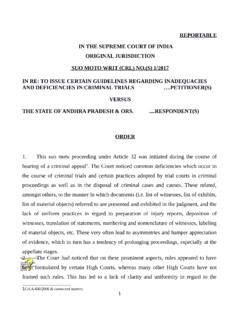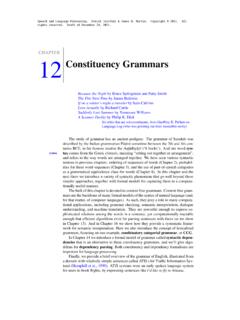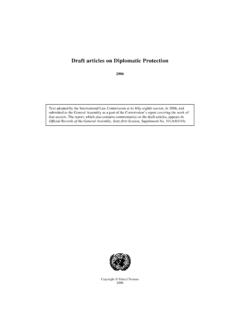Transcription of Public consultation document: Pillar One – Amount A: Draft ...
1 Public consultation DOCUMENT Pillar One Amount A: Draft Model rules for Tax Base Determinations18 February 2022 4 March 2022 | 1 Pillar ONE Amount A: Draft MODEL rules FOR TAX BASE DETERMINATIONS OECD 2022 Table of contents Background 2 General Articles and Definitions 5 2 | Pillar ONE Amount A: Draft MODEL rules FOR TAX BASE DETERMINATIONS OECD 2022 Background Introduction Following years of intensive negotiations to update and fundamentally reform international tax rules , 137 members of the OECD/G20 Inclusive Framework on BEPS (Inclusive Framework) joined the Statement on the Two- Pillar Solution to Address the Tax Challenges Arising from the Digitalisation of the Economy (the Statement) released in October 2021. The Statement sets out the political agreement on the key components of Pillar One and Pillar Two.
2 Amount A of Pillar One has been developed as part of the solution for addressing the tax challenges arising from the digitalisation of the economy. It introduces a new taxing right over a portion of the profit of large and highly profitable enterprises (hereafter, Covered Groups ) for jurisdictions in which goods or services are supplied or consumers are located (hereafter, market jurisdictions ). The Inclusive Framework has mandated the Task Force on the Digital Economy (TFDE) a subsidiary body to advance the work needed to implement Amount A. In particular, the TFDE has been charged with developing the Multilateral Convention (MLC) and its Explanatory Statement as well as the Model rules for Domestic Legislation (Model rules ) and related Commentary through which Amount A will be implemented. Model rules The Model rules , once finalised, will reflect the substantive agreement of the members of the Inclusive Framework on the functioning of Amount A and will serve as the basis for the substantive provisions that will be included in the MLC.
3 The Model rules are also being developed to provide a template that jurisdictions could use as the basis to give effect to the new taxing rights over Amount A in their domestic legislation. They will be supported by a commentary. Jurisdictions will be free to adapt these Model rules to reflect their own constitutional law, legal systems, and domestic considerations and practices for structure and wording of legislation as required, whilst ensuring implementation is consistent in substance with the agreed technical provisions governing the application of the new taxing rights. The Model rules will cover all aspects of Amount A that would be translated into domestic law. They will consist of different titles. This document contains the sections on tax base determinations (which are currently Title 5) as well as relevant definitions (currently included in Title 9) that are referenced in the sections on tax base determinations.
4 Model rules on Tax Base Determination This document contains the Draft Model rules for tax base determinations, which would be contained in Title 5 of the Model rules described above. It also contains relevant definitions (currently included in Title 9) that are referenced in the sections on tax base determinations. Both the Model rules for tax base determinations and the relevant definitions will be translated into the MLC and Explanatory Statement. The Model rules on Tax Base are designed to calculate the profit (or loss) of a Covered Group that will be used for Amount A calculation purposes. The tax base is therefore the measure of profit that forms the basis for partial reallocation under Amount A rules . Given that Amount A is a new taxing right that is determined based on the profits of a group (rather than on a separate entity basis), it is necessary to use consolidated group financial accounts as the starting point for computing the Amount A tax base.
5 This approach also has the advantage that the Amount A tax base is less affected by controlled transactions. The Draft Model rules in this document do not | 3 Pillar ONE Amount A: Draft MODEL rules FOR TAX BASE DETERMINATIONS OECD 2022 include the tax base rules that will be necessary for Covered Groups that are subject to segmentation for Amount A purposes, which will be released at a later date. Under the Model rules , Covered Groups would be required to calculate their profits using Qualifying Financial Accounting Standards (which are defined in the Model rules ) to ensure that the profit that is applied for Amount A purposes is not impacted by accounting practices that do not align with common practice. Given that the scope of Amount A includes only a limited number of large and highly profitable enterprises, it is anticipated that most such Covered Groups will be preparing financial accounts using these standards at present for commercial or regulatory purposes.
6 Further, the financial statements of Covered Groups would have to be subject to external audit, thus providing a reliable source of information that is typically readily available to tax administrations. Subject to specified exclusions, all items within the consolidated P&L statement will be taken into consideration to determine the tax base of the Covered Group. This means the computation of the Amount A tax base will start from the bottom line figure of the P&L statement ( the total for profit or loss). From this point, certain book-to -tax adjustments will be made (such as the deduction of certain items of income and the adding back of certain expenses) to arrive at a standardised Adjusted Profit Before Tax figure. The adjustments adopted reflect instances where the goals of accounting standards and Amount A may differ in some points, including occasions where adjustment is required to prevent potential double counting of income or to prevent the deduction of specified expenses for policy reasons.
7 For ease of administration and compliance, these adjustments will be kept to a minimum in order to limit complexity, and align where possible with adjustments under Pillar Two. Tax base is also subject to adjustment with respect to profit (or loss) restatements in relation to prior periods. Subject to certain limitations, restatements required under accounting rules are attributed to the tax base of the Covered Group in the period that the restatement is identified and recognised, rather th an going back and recalculating tax base for prior closed periods. This is expected to be consistent with the approach taken in relation to other elements of the Amount A calculation. To limit any reallocation under Amount A to economic profit, tax base determination is also subject to loss carry forward rules . These rules require that unrelieved losses of a Covered Group incurred in a prior period (hereafter, Net Losses ) are carried forward and offset against any subsequent profit of th at Group, following an earn-out mechanism.
8 Specific rules apply in a number of instances, such as for (a) pre-implementation losses ( Net Losses incurred prior to the introduction of Amount A), and (b) losses transferred following certain types of defined business reorganisations. The Model rules on tax base determination also consider the introduction of time limitations to the utilisation of Net Losses, a question that is still under discussion within the TFDE. Public consultation instructions This is a working document released by the OECD Secretariat for the purposes of obtaining input from stakeholders. It does not reflect the final views of the Inclusive Framework members. It presents the work undertaken to date, which has reached a sufficient level of detail and stability such that it is now suitable for consultation . The TFDE has agreed that this working version can be released on the basis that it is without prejudice to the final agreement.
9 As such, while the rules are intended to illustrate the framework for tax base determinations, and work-in -progress approach to a number of the rules , further changes may be made. Further changes may also be needed once the scope exclusions for Regulated Financial Services have been agreed, to ensure that the tax base determinations rules appropriately address the specificities of certain non-regulated financial services. Thus, the release of this document reflects consensus within the TFDE as a procedural matter that Public comments should be sought at this time, but does not reflect consensus within the TFDE regarding the substance of the document. 4 | Pillar ONE Amount A: Draft MODEL rules FOR TAX BASE DETERMINATIONS OECD 2022 Comments are sought with respect to the tax base determination rules in this document. Where relevant, input should refer to the relevant section of the rules .
10 While comments are invited on any aspect of the rules , input will be most helpful where it explains the additional guidance that would be needed to apply the rules to the circumstances of a particular type of business, as well as input on whether anything is missing or incomplete in the rules . Interested parties are invited to send their comments on this discussion Draft before 4 March, 2022. These comments will be examined at the following meeting of the TFDE. Comments on this discussion Draft should be sent electronically (in Word format) by email to and may be addressed to: Tax Treaties, Transfer Pricing and Financial Transactions Division OECD/CTPA. Please note that all written comments received will be made publicly available* on the OECD website. Comments submitted in the name of a collective grouping or coalition , or by any person submitting comments on behalf of another person or group of persons, should identify all enterprises or individuals who are members of that collective group, or the person(s) on whose behalf the commentator(s) are acting.

















